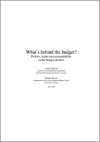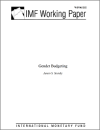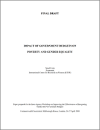FOUND 18
Examining the resources needed to implement Security Council Resolution 1325 at national level as well as the gains, gaps and glitches of financing the women peace and security agenda. Over the last decade the policy environment on women, peace and security has gained significant momentum.
Paper discussing the definition and measurement of Sustainable Development Goal (SDG) Indicator 5.c.1. (reclassified to Tier II) and comparing Indicator 5.c.1 with other SDG fiscal indicators.
Using country-level data, the paper estimates the costs of interventions aimed at promoting gender equality and women's empowerment in Bangladesh, Cambodia, Ghana, Tanzania, and Uganda. It then uses these estimates to calculate the costs of such interventions in other low-income countries.
This paper on SMEs in Vietnam, looks into biases that help explain the higher costs and lower profits of female-owned enterprises. It brings together gender analysis, small scale enterprise analysis, and gender budget analysis in a development context by demonstrating that gender mat
This background paper was prepared for the Commonwealth Secretariat in May 2007 by Mariama Williams, Adjunct Associate, Center of Concern, Washington DC and Research Adviser for the International Gender and Trade Network.
This IMF Working Paper examines how public processes can contribute to improving women's status. Gender budgeting, which refers to the systematic examination of budget programs and policies for their impact on women, has been tried in a range of countries in recent years.
The paper reviews the literature on the gender dimensions of taxation and the implications for tax policy with special reference to developing countries. It was commissioned by the Commonwealth Secretariat as part of the organization's commitment to integrate gender concerns into economic policy.
This document, represents the gender analysis that was conducted on Tanzania's 2003-2004 National Budget.
In this paper, Simel Esim (2000) focuses on expenditure and revenue instruments of fiscal policy as strategic entry points for engendering macroeconomics. The paper also includes a discussion of the potential implications of monetary policy and overall fiscal stance on poverty and gender equality.






